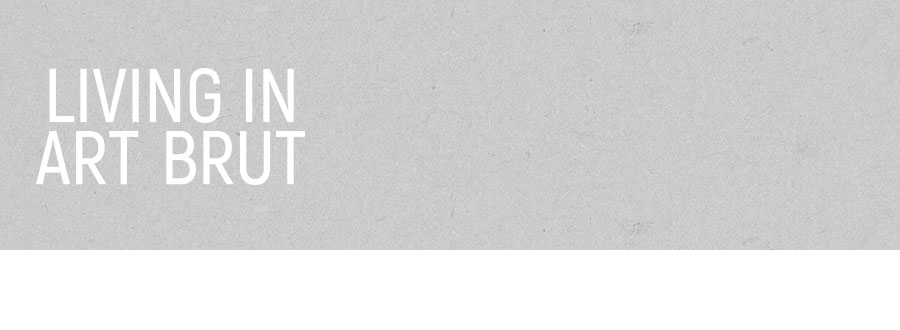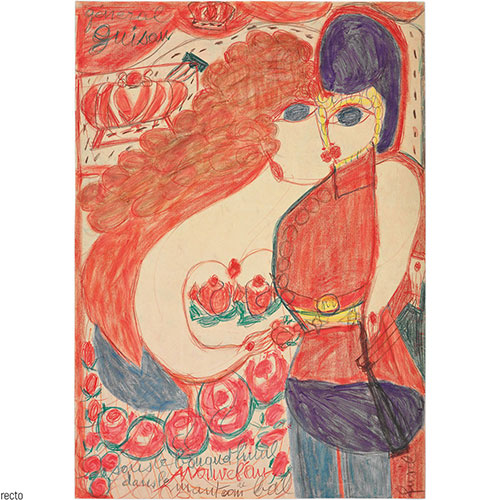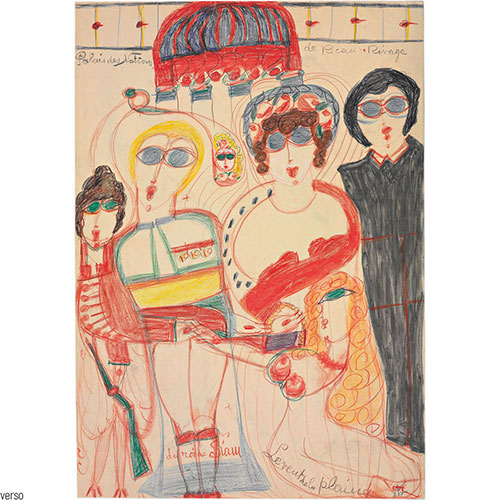Aloïse Corbaz
1886 to 1964, Switzerland
Aloïse Corbaz was born to a large family in Lausanne. Her father was a postal worker who turned to alcohol to deal with his internal stress. She lost her mother, who suffered from a heart condition, very early in life.
In 1906 she finished school and attended a vocational college for seamstresses, but never worked in the profession. She dreamt of becoming a singer, as she had a beautiful voice, had received private voice lessons and sang in the Lausanne Cathedral’s church choir. It was there that she discovered a great repertoire of operas. When she fell in love with a French former priest who had come to Lausanne to study Protestant theology, her sister Marguerite’s rigorous efforts prevented the relationship from going any further. In 1911 she moved to Potsdam, where she initially found work as a teacher, later working as a governess in the household of the court chaplain at Sans-Souci, not far from the emperor. Her life was marked by a blend of Puritanical severity and imperial splendour. Thanks to her voice, she also sang in the presence of the emperor in the palace chapel. This led to an obsessive and fanciful passion for Wilhelm II that never left her in peace. In 1913 she returned to Lausanne, taking up temporary work here and there. She began to experience delusions, wrote religious tracts on the world’s salvation, spread propaganda against the military and promoted a vegetarian lifestyle. As a result of her psychiatric problems, she was confined to the university’s clinic in Cery between 1918 and 1920. The doctors there spoke of “paranoid schizophrenia”. After that she was transferred to La Rosière in Gimel, where she remained until her death 44 years later.
Here she was kept occupied by ironing the nurses’ aprons. Soon, however, she began filling the hours after work with writing and drawing, in complete secrecy. Almost none of her early work has survived. Not until 1936 did Professor Hans Steck, the director of the psychiatric hospital, and then, in 1941, her physician Dr Jacqueline Porret-Forel discover her magnificent artwork. Aloïse Corbaz was already 55 years old by this time. From that point forward, she was given drawing supplies. Jacqueline Porret-Forel also brought her to the attention of Jean Dubuffet, who immediately recognised the greatness of her artwork, supporting her and exhibiting her drawings. This meeting was a decisive step in the history of Art Brut, and Aloïse Corbaz is still today considered this genre’s most important female representative. Aloïse always used both sides of the paper and worked with either coloured pencils or oil pastels. Sometimes she would add toothpaste, fruit juices or flower petals. Her primary subjects were mystical love scenes characterised by a rich use of colour and complexity, full of queens and kings, princes and princesses, generals, anonymous officers, popes, bishops, circus performers, etc. Blue eyes are a characteristic feature shared by her figures. To create larger works – some more than 10 metres in size – she would sew numerous pages together with thread.
Her creative activity might be considered an attempt to reconstitute her identity, something she succeeded in doing on a mythical level through her artistic work. Her creations – inspired by operas – are set on a stage of the Theatre of the Universe. She was also familiar with the masterpieces of classical painting and recreated them in her very own colourful and imaginative style.
Her most important works are found in the Collection de l’Art Brut in Lausanne, the Kunstmuseum Solothurn, Switzerland, as well as in the Collection of Christine and Jean-David Mermod, Lausanne, Switzerland, the Collection Philippe Eternod and Jean-David Mermod, Lausanne, Switzerland, and the Collection abcd/Bruno Decharme, France. As of 2021, Aloïse Corbaz has also been represented in the 921 works of the “Donation d'Art Brut de Bruno Decharme” at the Centre Pompidou in Paris.
Selected works




